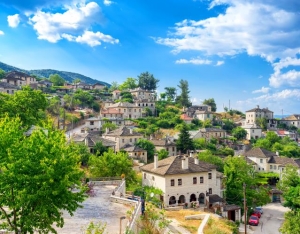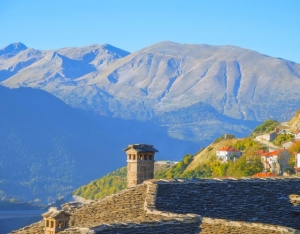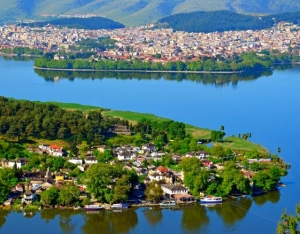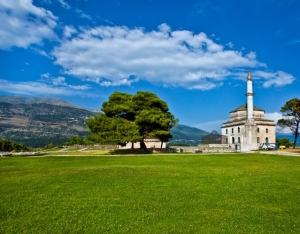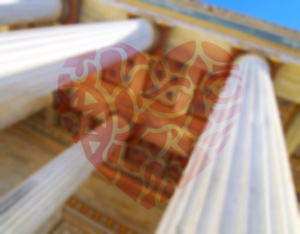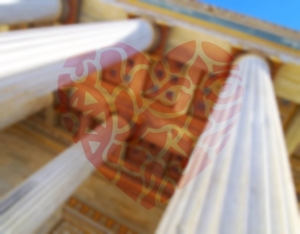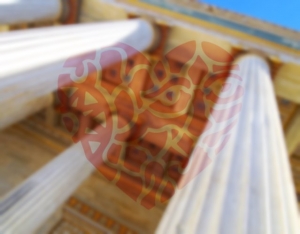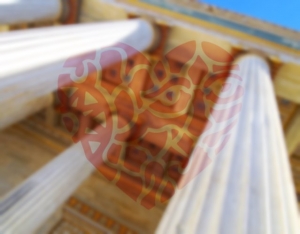Thodoris Bgenopoulos
The famous villages of Zagorohoria are scattered in the mountains of Ioannina, connected by zig-zag roads.
Zagorohoria is a cluster of 46 villages in the region of Zagori, which spreads over an area of about one thousand square kilometers. Zagori is divided into three geographical sections: eastern, central and western Zagori.
Its name is really interesting, having Slavic root from the prefix "Za" that means "behind" and the noun "gora" that means "mountain". This is precisely what Zagorohoria is: many mountain villages that stand out due to their special architecture and the incredible natural beauty.
Zagorohoria is one of the most popular mountain destinations in Greece. One could say that its 46 villages compete with each other, both in beauty and infrastructure, resulting only to ultimate satisfaction and joy for the visitor. Picturesque stone houses, pristine forests, ancient stone bridges, monasteries and the indescribable natural beauty of the area, create a unique setting that attracts thousands of visitors every year.
In Zagorohoria you will find excellent traditional hotels to unwind and leave the stress behind. Do not forget to have a good night's sleep, before you begin your adventures in nature. Apart from the hotels, you will find great restaurants that will make sure to satisfy your hunger and let you in the secrets of greek cuisine. Afterwards you have the chance to try traditional desserts and relax, cuddling your coffee mug or your drink in several cafes and bars.
So many things can be written for Zagorohoria, yet nothing compares to the real thing. Vacations in Zagorohoria grant an escape from the hectic city life, a unique experience amidst the luscious greenery that you have to live.
Metsovo is in the eastern part of Ioannina.
Built on the slopes of mount Pindos, Metsovo is a beautiful traditional village that has recently developed into a great touristic destination. Besides its massive natural beauty, it also has remarkable ski areas attracting thousands of winter sports enthusiasts every year.
If you find yourself in Metsovo, you can visit the Folklore Museum of Metsovo and the Averof gallery. Once you get hungry, several quality choices for food,coffee or drinks await for you, together with excellent guest houses and hotels to stay overnight. If you have visited Greece before, you know that Greeks embrace tradition while innovating. As elsewhere in the country, here too a variety of local products is available for you to taste or buy. Do not miss the famous "Metsovone" cheese and the wonderful wine "Katogi Averof" (you can thank us later)!
Ioannina, also known as Giannina or Giannena is the largest city not only of the wider region of Ioannina, but also of the entire Epirus, with over 110,000 residents. Ioannina has a rich cultural tradition and remarkable beauty ; lake Pamvotis which is also known as Ioannina lake adds to that a dreamlike sensation.
There are so many things to see and do in Ioannina that you will definitely wish that days lasted over 24 hours. Start with a walk to the impressive castle of Ioannina, where you will have the chance to visit the Municipal Ethnographic Museum of Ioannina and the Byzantine Museum of Ioannina. Leaving the castle, do not miss the Archaeological Museum of Ioannina and right after, head to Lake Pamvotis and the island located in its center. There, you will admire the traditional village and the Ali Pasha Museum, which is dedicated to the man that governed the city during the Ottoman occupation. Take the small boat to enjoy the idyllic scenery and upon your return to the city, you will find several quality dining options. Taverns, mezedopoleia (traditional greek places where small food plates are served with ouzo or tsipouro) and restaurants have to offer a variety of delightful tastes, together with cafes and bars for a cup of coffee and drinks.
Once night falls, you have the chance to experience the amazing nightlife of Ioannina or select one of the excellent hotels and guest houses for a good night's sleep. Your next morning can be dedicated to trips! You can choose among short tours in Perama Cave, the archaeological site at Dodona, the Pavlos Vrellis Museum of Greek History and Wax Effigies or the nearby villages of Zagorohoria.
There are so many things to do in Ioannina, that you will definitely want to come back!
Evidence shows that the region of Epirus has been inhabited since the Palaeolithic era.
It was around 1300 BC, when the Molossians appeared in the region of Ioannina and dominated the area. Molossians, a strong nation with expansionist aspirations, acquired kinship with the kingdom of Macedon, by marrying the daughter of the king, Olympiad, with Philip II, king of Macedon. The fruit of this marriage was Alexander the Great, one of the greatest leaders the world has ever seen.
In the history of the region, the Molossian king, Pyrrhus, played a special role. Bringing together all the inhabitants of Epirus in 295 BC, he marched to Italy in an effort to expand his kingdom to the West. Pyrrhus had a series of victories, yet the losses suffered by his army were so large, resembling defeats, that he was forced to retreat. Any such victory in history is now called "Pyrrhic Victory".
In 168 BC Epirus was wholly conquered by the Romans, paying the price for supporting the Macedonians. Many cities were destroyed and their inhabitants were sold as slaves. During the Byzantine times, the area was fortified and the city of Ioannina was founded, being the second most important city in the Despotate of Epirus after Arta.
The region manages to secure a number of economic and other benefits from the Ottoman Empire and thus experiences major growth in trade, silversmith and goldsmith. Especially during the 17the and the 18the century, great spiritual development takes place. This is perfectly described by the popular saying "Ioannina, first in chariots, in money and in letters."
The region of Ioannina is finally liberated with the Balkan Wars in 1921-1923, and unifies with the rest of Greece. The Second World War is a period of fierce battles with both Italian and German troops. To make matters worse, the Greek Civil War that followed created --among others-- a major economic problem and forced several residents to emigrate.
Ioannina is located in Epirus, in western Greece.
With an area of 5000 square kilometers, it is the largest prefecture in Epirus and one of the largest in Greece. Ioannina borders Albania in the north, the region of Kastoria in the northeast, Grevena and Trikala in the east, Thesprotia in the west and in the south it borders two very beautiful Greek areas, that of Arta and Preveza.
Its capital is the city of Ioannina (or Giannena/Giannina), while other well known towns are Konitsa and Metsovo. A special mention should be made of the famous Zagorohoria, a cluster of 46 extremely scenic villages that are a top tourist destination.
The area of Ioannina is mostly mountainous. Among them, four stand out: mount Tymphi/Gamila (2497 m.), mount Grammos (2521 m.), mount Smolikas (2631 m.) and mount Lakmos/Peristeri (2294 m.) Ioannina is quite rich in water, as in its territory there are rivers Arachthos, Louros, Aoos, Kalamas, Voidomatis and Lake Pamvotis.
The climate in Ioannina is continental, with cold winters and frequent rainfalls that make the city slightly melancholic. Its population is approaching the 200 thousand inhabitants, many of whom are students or residents engaged in farming and agriculture. Tourism is another favored occupation in the region, as well as in Zagorohoria.
The Cultural Center Hellenic Cosmos is in Piraeus Street, the road connecting Athens to Piraeus.
The Cultural Center Hellenic Cosmos is a modern cultural center and museum that stands out for its innovative programs. Founded in 1998, it was an initiative of the Foundation of the Hellenic World and the Efraimoglou family.
Its total area of 60 acres hosts a wide range of activities related to Greek history and culture such as:
- Interactive exhibitions
- Virtual Reality Tours
- Educational programs
- Conferences
- Theatrical performances
- Documentaries
- Artistic events
In 2006 the inauguration of "Tholos", took place. This is the new semi-spherical Virtual Reality theater where digital productions of the Foundation of the Hellenic World are presented.
The "Dome" is a hemispherical building with a capacity of 132 people and unique technological infrastructure, which resembles a planetarium but is much more sophisticated. Only by experiencing it from the inside, will you realize the uniqueness of the experience offered. The projections are interactive and controlled by the viewer, with themes like "Journey to Ancient Olympia", "Journey to the Ancient Agora" etc, making the viewer feel that he is actually in a fantastic journey through time.
The newest addition to the Cultural Center Hellenic Cosmos is the "Theatron", a multi functional space aiming to host contemporary artistic creation and expression.
"Theatron" features a unique audio-visual equipment and is designed so that it can accommodate the most demanding productions: theatrical and musical performances, concerts, conferences, corporate events, exhibitions and spectacles with particular stage demands.
A visit to the Cultural Center Hellenic Cosmos will undoubtedly leave you more than satisfied.
Cultural Center Hellenic Cosmos: Address, Piraeus Street 254, Tavros
More information concerning the Cultural Center Hellenic Cosmos can be found in www.hellenic-cosmos.gr and the number 212 2540000.
The Park of Naval Tradition - Averof is in Trocadero, in the area of Paleo Faliro, about 8 km from the center of Athens.
Of course, the Averof Battleship holds a special place, being a top exhibit of the park. The battleship was launched in 1910 and was named after the national benefactor Georgios Averof who paid much of the price of the ship.
The Averof Battleship dominated the Aegean during the Balkan Wars and played a key role in the victory of the Greeks. Until its decommissioning in 1952, it constituted the flagship of the Greek fleet.
Today it is a unique ship & floating museum that can be visited almost throughout, allowing visitors to see first hand not just a boat but a living part of the modern Greek history.
At the Park of Naval Tradition, besides the famous Averof battleship, you can also see:
- The sailboat Evagelistria, one of the last authentic sailing boats
- The steamer "Thales of Miletus," the oldest cable ship in the world
- The Athenian trireme "Olympias" , a replica of the ship used by ancient Athenians
- The torpedo boat Velos
- The sailboat "Eugene Eugenides"
Those who love the sea and the ships will definitely love the Park of Maritime Tradition - Averof.
Park of Naval Tradition- Averof: Address, Marina Flisvos -Trokantero, Paleo Faliro.
More information concerning the Park of Naval Tradition- Averof can be found in www.averof.mil.gr and the number 210 9888211.
The Frissiras Museum is in the central neighborhood of Athens, Plaka.
It is the only museum in Greece, dedicated to modern European painting. Established by the family of Vlassis Frissiras, the Frissiras Museum includes exhibits of paintings, drawings, sculptures and engravings by European artists. The aim of the museum is to document the trends, the people and the philosophy of the anthropocentric European painting after 1940.
The Frissiras Museum organizes temporary exhibitions of similar topics to the museum, and various events.
Frissiras Museum: Address, Monis Asteriou 3 Street, Plaka, Athens.
More information concerning the Frissiras Museum can be found in www.frissirasmuseum.gr and the number 210 3234678.
The Numismatic Museum is situated in the center of Athens, almost next to Syntagma Square. The museum was founded in 1834, the creation of the coin collection begun immediately and was hosted in different places until it finally acquired a permanent home in 1998.
The museum is housed since 1998 in Ilion Melathron, a beautiful 19th century mansion by the famous German architect Ziller. The building was originally the residence of the famous archaeologist Heinrich Schliemann who discovered the legendary Troy. The interior spaces of the building are decorated with impressive frescoes and mosaics inspired by the findings from the excavations at Troy and Mycenae.
Exploring the first floor, the visitor has the chance to learn more about the ancient Greek currency, the history of the Numismatic Museum, as well as the building's first inhabitat, Heinrich Schliemann.
On the second floor of the building there is a permanent exhibition on the history of coinage from Roman times to today.
Numismatic Museum: Address, Panepistimiou 12 Street, Athens.
More information concerning the Numismatic Museum can be found in www.nma.gr and the number 210 3632057.
The Goulandris Museum of Natural History is in the northern suberbs, in Kifisia, 15 km from the center of Athens.
It was founded by Agelos and Niki Goulandris in 1964. Originally, it operated as a Botanic Museum, while in 1977 it expanded in the areas of zoology, paleontology and geology.
The museum is inspired by the famous Natural History Museum of London, with which it cooperates, and has permanent exhibitions with stuffed animals, insects, plants, rocks and animal fossils.
In 1999 the Goulandris Natural History Museum created the Center for Environmental Research and Education GAIA, to serve as the museum of the future, devising a new environmental policy both in Greece and internationally. The GAIA Centre presents to visitors the evolution and functioning of planet Earth and its current state.
On the museum premises you will also find an excellent café-restaurant and a shop.
Goulandris Museum of Natural History: Address, Levidou 13 street & Othonos, Kifissia.
More information concerning the Goulandris Museum of Natural History can be found in www.gnhm.gr and the number 210 8015870.

